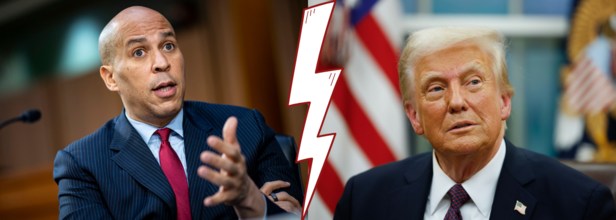- Health Conditions A-Z
- Health & Wellness
- Nutrition
- Fitness
- Health News
- Ayurveda
- Videos
- Medicine A-Z
- Parenting
- Web Stories
Senator Cory Booker's Longest Speech In History Criticizes Trump's Health Policy, Details Inside

(L to R) Democratic Senator Cory Booker; US President Donald Trump (Getty Images)
Senator Cory Broker, a Democrat from New Jersey delivered the longest recorded speech in Senate history. This has surpassed Strom Thurmond's 1957 filibuster against civil rights legislation. Booker's speech lasted for over 24 hours and was indeed a passionate critique of Trump administration's healthcare policies, especially its proposed cuts to Medicaid and other essential health programs.
His speech was framed as a moral stand against what he described as a 'healthcare crisis' in the United States.
The Democrat's marathon address was a symbolic protest against President Donald Trump, where he warned of the "grave and urgent" moment in American history. It went on for 25 hour and four minutes. The speech started at 7pm on Monday, where he vowed to speak as long as he is "physically able" to and ended past sunset on Tuesday, at 8.05 pm.
What Was The 25-hour Speech All About?
Booker began his speech not just tied to a specific bill but aimed to delay a vote on a Democratic-led measure to overturn Trump's tariffs on Canada. His decision to speak for such an extended period was also symbolic. He opposed the idea that the longest Senate speech was held by a segregationist.
His speech was heavily focused on healthcare policy and was addressed at Trump administration's efforts to cut funding for key health programs. These included:
Medicaid Cuts: He condemned Trump's budget proposals which sought to significantly reduce Medicaid funding. He argued that such cuts could harm low-income Americans and people with disabilities.
Access to Affordable Care: He also criticized the administration's attempts to dismantle the Affordable Care Act, which he said had expanded healthcare access for millions.
Maternal and Child Health: He then went on to highlight how cuts to government health programs would disproportionately affect pregnant women, infants, and children in vulnerable communities.
Pharmaceutical Industry Influence: He also spoke abut the rising cost of prescribed drugs. He accused the administration of failing to hold pharmaceutical companies accountable for their actions.
Policies That Booker Opposed
The main focus of his speech was his opposition to Trump's repeated attempts to weaken the healthcare protections. He argued that the administration's policies often prioritized tax cuts for the wealthy, hinting that Trump administration operates like a business and not like the government of the people. These tax cuts for wealthy are made at the expense of funding essential health services. He also denounced Trump's efforts to impose work requirements on Medicaid recipients, which he said would strip millions of Americans of healthcare coverage.
What Was The Reaction Like?
As Booker went on record, there were cheers everywhere in the Senate chamber. He also acknowledged Thurmond's legacy while emphasizing that he stood in defiance of the policies Thurmond had supported. Democrats, including Senate Minority Leader Chuck Schumer also praised his stamina and message and called it "tour de force".
The White House dismissed the speech, calling it a "publicity stunt" and referencing a precious moment when Booker declared "I am Spartacus" during Brett Kavanaugh's Supreme Court confirmation hearings.
In all, Booker remained firm in his belief that this was indeed a "moral moment" and it required action. His record-breaking speech was not just about policy, but more than that. It was about defending fundamental right to healthcare for all Americans.
“This is not right or left, it is right or wrong,” he declared. “This is not a partisan moment. It is a moral moment. Where do you stand?”
XFG ‘Stratus’ COVID Now Dominant in US: States With Highest Cases and How to Spot Unique Symptoms

Credits: Canva
The XFG “Stratus” COVID-19 variant is officially strutting into the pandemic spotlight. It is new, it is bold, and according to the latest data from the Centres for Disease Control and Prevention (CDC), it is now the third most common variant in the US. But it is popping up in certain states more than others, and the way it announces its arrival could be by making your throat feel like you have swallowed a box of sandpaper.
While the national Covid-19 test positivity rate sits in the 5–9.9 per cent range, a dozen states are seeing significantly higher numbers.
According to CDC data, the states with the highest positivity rates are:
- New Mexico (12%)
- Texas (12%)
- Oklahoma (12%)
- Arkansas (12%)
- Louisiana (12%)
- Nevada (11.3%)
- Arizona (11.3%)
- California (11.3%)
- Alaska (11.1%)
- Washington (11.1%)
- Oregon (11.1%)
- Idaho (11.1%)
These states are not just reporting higher numbers but are also providing ideal conditions for Stratus to spread. With case trends officially “growing” according to the CDC, it is a situation that demands close attention.
Stratus is a variant under monitoring by the World Health Organisation (WHO). First detected in January, XFG Stratus now accounts for about 14 per cent of Covid cases in the US.
While theW says the health risk from Stratus remains low at a global level, this variant is still on a growth spurt, outpacing other circulating forms of the virus, including its sibling, the “Nimbus” NB.1.8.1 variant. The concerning bit is that the WHO says Stratus could be more adept at sidestepping immune defences. The reassuring bit is that the current vaccines are expected to continue protecting against symptomatic and severe disease caused by Stratus.
Spotting Unique Stratus Symptoms
The tricky thing about Stratus is that it is not trying to reinvent the Covid symptom wheel. According to experts, its symptoms look suspiciously similar to other recent Omicron descendants. But there is one possible stand-out, a sensation some patients are calling “razor blade throat”.
Here’s the full checklist:
- Sore throat (sometimes severe)
- Cough
- Congestion or runny nose
- Fever or chills
- Shortness of breath
- Loss of taste or smell
- Fatigue
- Headache
- Muscle aches
- Nausea, vomiting or diarrhoea
The “razor blade throat” description might sound too much, but anyone who has had that burning, scratchy pain knows it is no joke. Hoarseness has also been reported more often lately. Still, a sore throat has been a hallmark Covid symptom since the early days of the pandemic; Stratus just seems to be leaning into it.
Why the Positivity Spike Matters
Higher positivity rates do not just mean more people are testing positive; they can also signal under-testing. If more than 10 per cent of people tested are infected, it suggests many cases are flying under the radar, which means more opportunities for the virus to spread unchecked. That is especially risky when you have a variant with a knack for growing its share of cases quickly, like Stratus.
The fact that 12 states are sitting above the 11 per cent mark means public health teams will be watching these regions closely in the coming weeks. In the meantime, everyday precautions like masking in crowded places, testing if symptomatic, and staying up to date with vaccines remain the best tools in the toolbox.
Stratus vs. Nimbus
While Stratus is currently the one hogging headlines, it is not alone. The “Nimbus” NB.1.8.1 variant is still in the mix, though it is being outpaced by Stratus globally.
For now, Stratus is the one to watch and not because it is the most dangerous, but because it is the fastest climber.
Final Forecast
The XFG Stratus variant is not changing anything, but it is a reminder that the virus is still evolving and still finding ways to make itself known. Got a sudden sore throat that feels like sandpaper? Do not brush it off. Stratus may not be a storm you can see on a weather map, but it is definitely in the air.
UK Health Chiefs Warn of Rising Cases of Deadly Chikungunya Virus That Can Cause Body to ‘Fold In on Itself’

Credits: Canva
Health authorities in the UK have reported a significant rise in chikungunya cases, a mosquito-borne disease known for causing severe joint pain that can leave sufferers hunched over. Between January and June 2025, there were 73 confirmed cases in England, Wales, and Northern Ireland, more than double the 27 recorded during the same period in 2024. The UK Health Security Agency (UKHSA) says this is the highest number ever recorded, with nearly all linked to overseas travel.
What is Chikungunya?
Spread by the bite of infected Aedes mosquitoes, particularly the Aedes aegypti and Aedes albopictus species, chikungunya is not usually deadly but can be devastating for the very young, the elderly, or those with underlying health conditions.
Typical symptoms include:
- Excruciating joint pain that can leave sufferers bent over in agony
- High fever and headaches
- Muscle aches and swelling in the joints (especially hands and feet)
- Nausea, fatigue, and a rash that’s red, bumpy, and decidedly not Instagrammable
In severe cases, the arthritis-like pain can linger for months or even years, turning every movement into a reminder that mosquitoes are not just a mild holiday nuisance.
The majority of UK cases this year were linked to travel to Sri Lanka, India, and Mauritius. All were reported in England, with London taking the dubious honour of having the most cases. However, the two mosquito species that spread the virus are not established in the UK, so there is no risk of it transmitting locally.
UK logs first cases of oropouche virus
As if one virus was not enough, the UK has also logged its first cases of the oropouche virus, also dubbed ‘sloth fever’. This one circulates in the wild between primates, sloths, and birds before occasionally hopping over to humans via midges or mosquitoes.
Found primarily in the Amazon basin, oropouche has recently started wandering further across the Americas. All the UK cases were linked to travel from Brazil, so unless your staycation involves tree-dwelling mammals and tropical insects, you are safe for now.
The Global Bug Crawl
Chikungunya is typically found in Africa and southern Asia, but 2025 has seen it pop up in unexpected places. Outbreaks have been reported in China, the Indian Ocean islands of Reunion, Mayotte and Mauritius, and across the Americas. In southern China, more than 7,000 people have been infected since June, prompting COVID-style lockdowns in Foshan and at least a dozen other cities in Guangdong province. Hong Kong and Taiwan have also reported cases.
Health officials are urging travellers to take bite prevention seriously.
How to safeguard against mosquito bites
According to the US Centres for Disease Control and Prevention (CDC), your best defence is to stop mosquitoes from making contact in the first place.
Top tips include:
- Use Environmental Protection Agency (EPA)-registered insect repellent
- Wear long-sleeved shirts and trousers (mosquitoes can’t bite what they can’t reach)
- Treat clothing and gear with 0.5% permethrin for extra armour
- Choose accommodation with air conditioning or window screens
- If sleeping outdoors, use a mosquito net unless you enjoy sharing your bed with the local insect population
Vaccination
In addition to covering up and dousing yourself in repellent, some travellers may be advised to get the chikungunya vaccine before heading to certain destinations. Your healthcare provider can help you decide if this applies to your travel plans.
Why the Surge Now?
Several factors could be behind the sharp rise in cases. Increased international travel post-pandemic, changing weather patterns favouring mosquito breeding, and outbreaks in popular holiday destinations have created a perfect storm. Mosquitoes thrive in warm, wet conditions, and with climate change extending those conditions into more regions, these viruses are no longer staying politely within their old borders.
Chikungunya virus can turn a dream getaway into a painful endurance test, and once contracted, it is all about managing symptoms; there is no cure. The same goes for oropouche: prevention is your best friend. In the world of tropical diseases, an ounce of repellent really is worth a pound of cure.
Scott Swift, Taylor Swift's Dad Underwent A Quintuple Bypass Heart Surgery, Here's What We Know About It So Far

Credits: Treemily
Scott Swift, 73, pop singer Taylor Swift's dad just underwent a quintuple bypass surgery, revealed Taylor during one of the episodes of Travis Kelce and Jason Kelce's New Heights podcast.
She also shared that she had moved in with her dad earlier this year to take care of him for a speedy recovery. She noted that her father has been full of gratitude after the surgery. "He was the loveliest patient ever. He just kept saying thank you over and over again."
Why Did Scott Swift Need A Surgery?
Taylor called the surgery "really intense" and said that her dad's heart always had a healthy ECG or electrocardiogram. He also ensures to get it every year to remain a step ahead of any physical ailments. However, five hard blockages were found in his heart during a resting stress test.
"He's been telling all his friends, 'You need to get the stress test,' because that's what's actually preventative. If you can find that earlier, you don't have to have a bypass surgery," she said.
Taylor confirmed that her father is doing "incredibly well" and that his humor has helped him go through during the hard times. It still is very much intact in him.
She shares that he did not know how many blockages he's had, on being told that he underwent a quintuple bypass, which means five blockages, he also joked about it. "Well, you see, I come from a very competitive family," he told Taylor.
What Is A Stress Test?

As per the National Institute of Health (NIH), US, it is a form of physical test that typically utilizes electrocardiography along with blood pressure monitoring and exercise, which involves a treadmill or bicycle.
However, in a resting stress test, the assessment happens when the heart muscle is at rest after stress. This stress helps in identifying areas of reduced blood flow like ischemia or damage to the heart muscle, which can indicate conditions like coronary artery disease.
The test involves injecting a radioactive tracer into the bloodstream, then using a special camera to take images of the heart at rest and after stress.
What Is A Bypass Surgery?

As per Johns Hopkins Medicine, bypass surgery or coronary artery bypass graft surgery (CABG) is a procedure used to treat coronary artery disease. Coronary artery disease (CAD) is the narrowing of the coronary arteries. These are the blood vessels that supply oxygen and nutrients to the heart muscle. CAD is caused by a build-up of fatty material within the walls of the arteries. This buildup narrows the inside of the arteries, limiting the supply of oxygen-rich blood to the heart muscle.
How Does It Work?
One way to treat the blocked or narrowed arteries is to bypass the blocked portion of the coronary artery with a piece of a healthy blood vessel from elsewhere in your body. Blood vessels, or grafts, used for the bypass procedure may be pieces of a vein from your leg or an artery in your chest. An artery from your wrist may also be used.
ALSO READ: 4 Rare Heart Diseases That Are Becoming Common By Each Passing Day
This surgery is done to treat a blockage or narrowing of one or more of the coronary arteries. It can restore the blood supply to your heart muscle when nonsurgical procedures are not a choice.
More Updates From The Swift Family
In addition to Scott, Taylor shared that her mom Andrea Swift, too, under a procedure. “My mom just got a new knee,” Taylor shared. “She’s doing great. She’s scampering around. We’re not quite at scampering yet, but she’s doing great.”
She noted that her parents are her best friends.
"It was actually one of the most special things that's ever happened to me, spending all that time with them this summer. You have those long talks that you don't have when it's a small, concentrated period of time.”
© 2024 Bennett, Coleman & Company Limited



